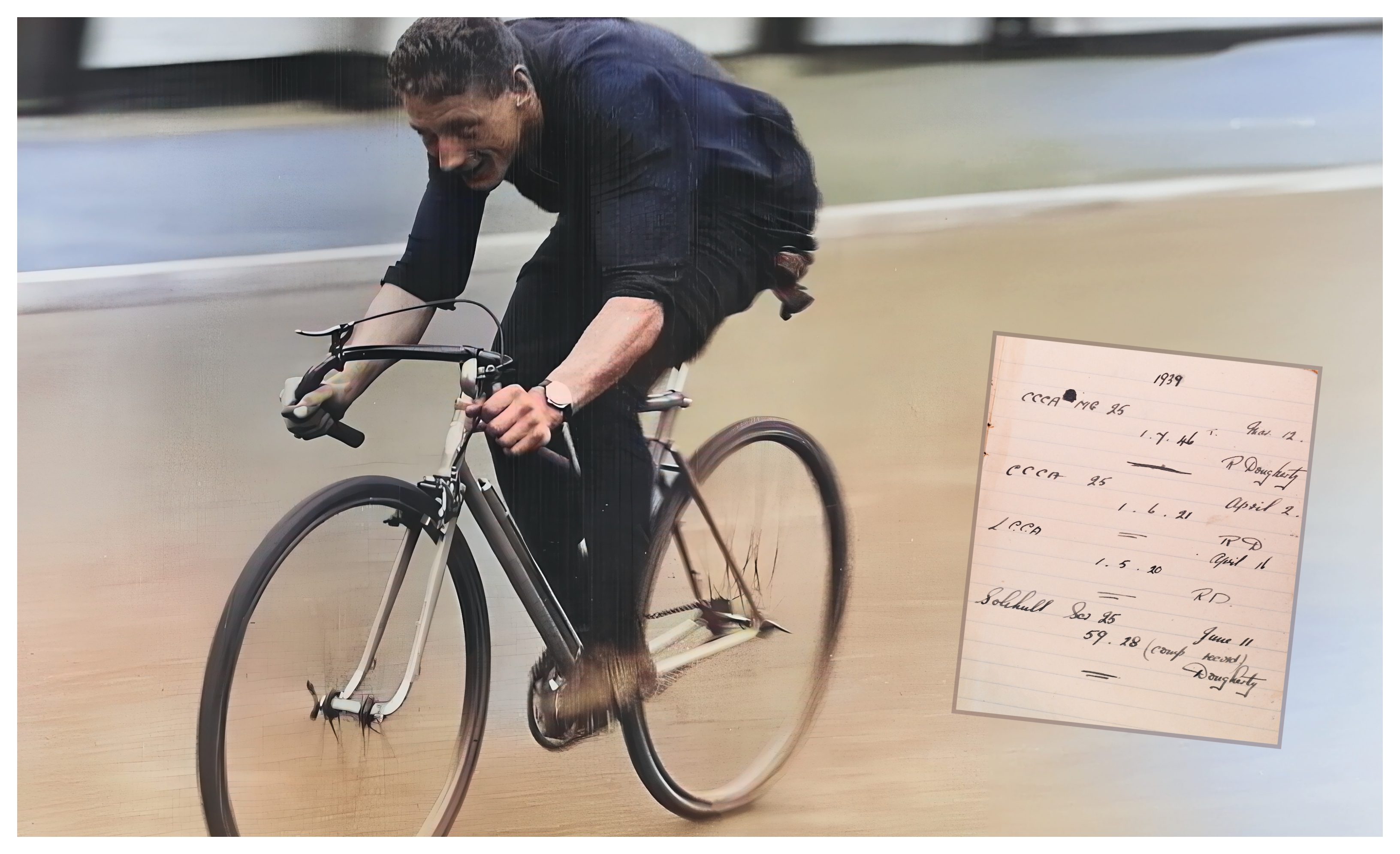
"And that beats the hour" – five words that danced momentarily in the air on 11 June, 1939, tripping off the tongue of an astonished timekeeper as rider number 14 flashed across the line. For the first time in history, a cyclist had covered 25 miles in less than 60 minutes in the UK.
It marked a watershed moment for UK cycling, comparable to Roger Bannister's exploits on the athletics track 15 years later. So why is Ralph Dougherty, the rider who achieved that first sub-hour ‘25’, not a household name?
TT bad boy
Britain is fond of its time trialling icons and their exploits. Many will have heard of the bespectacled Ray Booty and his first sub-four-hour '100' in 1956; or Alf Engers and his first sub-50-minute '25' in 1978 – Engers is remembered as the ostentatious bad boy of the 70s who turned up at events in a fur coat and a Jaguar.
But Dougherty’s name remains conspicuous by its absence from this hall of fame – he is rarely talked about even within the world of time trialling.
In 1939, Dougherty became the first rider to go under the hour for 25 miles in an RTTC-recognised event in Britain, at a time when competitors flapped their way along sub-par roads wearing alpaca jackets and riding heavy bikes, with not even a nod to aerodynamics.
A huge achievement. As Cycling Weekly reported at the time, a sub-hour '25' was "the ambition of every 25-miler", and remains a benchmark even today.

While Dougherty's name may not be as celebrated as perhaps it ought to be, he remains a hero at his former club Rugby Racing Cycling Club, who for the past two seasons have commemorated his ride with their 'Rugby Flyer' 25-mile time trial.
Rugby Flyer was the nickname Dougherty had earned for himself by dint of his exploits against the clock. It was also a reference to his hometown, of course, where he worked as a toolmaker and electrician for English Electric.
The club's annual commemoration goes beyond a mere race, because Dougherty's son Maurice, now 86, and grandson Andy, 62, are part of the event. What's more, Andy still owns the record-breaking bike, a fixed-wheel BSA, as well as the Rugby Flyer's old training diaries and certificates.
Dougherty set his record in the Solihull CC 25-mile time trial on 11 June, 1939, recording 59.29 to beat the previous best mark by 43 seconds. It was clearly a good day for it, with the previous record holder, George Nightingale (Charlotteville CC) also beating the hour with 59.36, just 18 minutes after Dougherty ripped home.
Held on a course just east of Birmingham, taking in Stonebridge and the Meriden Cross – the dead centre of England – the event featured two 'turns in the road' (this was a time when traffic allowed for such things) and, according to Cycling Weekly, "a track-like surface".
Though Dougherty’s was the first official sub-hour ‘25’, in Ireland Alo Donegan had recorded a 59.05 in 1935 and George Fleming a 57.56 in 1938.
Dress to impress
Being in Ireland, neither ride was RTTC-compliant, with riders permitted to wear shorts – tantamount to cheating by English standards, which obliged long trousers. Fleming had been on the start list of the Solihull event but had tired himself out by racing the previous day, so did not start, something he would presumably live to regret.
The most recent Rugby Flyer event, held in September, Andy and Maurice Dougherty were both in attendance, with Andy presenting the prizes accompanied by his grandfather's old machine – fresh from being restored by Tim Gunn, well known for being the cycle restorer in the TV show The Repair Shop.

Andy, who was a teenager when his grandfather gave him the bike, says: "There was no question I was in awe of him. I knew he was a brilliant cyclist, and I was always very impressed and very proud of him.
He wasn't a big, loud, outgoing person; he was quite a quiet person." Was his grandfather proud of his achievements? "He didn't make a big deal about things. I can never remember him actually boasting about stuff."
Andy remember’s how, thanks to his skills as a tool-maker, Ralph could "turn his hand to almost anything".
As a case in point, the elder Dougherty made a sledge that he christened the 'Dougherty Flyer' and presented to a young Andy and his brother Tim as a surprise gift. "It was just a superb piece of engineering, with sculpted sides and runners,” remembers Andy. “We were just gobsmacked.”
Always awheel
Ralph Dougherty joined the RRCC in the early 1930s, where he made his name, though he had joined the local Leamington C&AC club by the time of his record ride. He was rarely off his bike, according to Andy.
"He rode pretty much every day, for most of his life. He was a cyclist, that was it, he didn't really do any other sports."
Andy references a local newspaper article, written "quite late on" in Dougherty's life, that records his grandfather as continuing to ride 200 miles every week.
Ralph Dougherty passed away in 1990, but his spirit lives on in both the clubs he was a member of and – far more publicly – on Rugby's Viaduct Cycleway, where a sculpture of him, crouched low over his handlebars just as he did on 11 June, 1939, urges passing riders on from the side of the trail.

The Flyer flies again
Not long before he left for university in the early 1980s, Andy Dougherty received a special gift from his record-breaking grandfather: the very bike, a BSA, on which he rode the first ever UK sub-one-hour 25-mile time trial. The bottom bracket shell, threads stripped out through decades of wear, needed replacing but beyond that, it was in working order.
When Andy Dougherty took delivery of it, he set about modernising his new steed, changing wheels and tyres and shoehorning a derailleur into the frame in place of the original fixed wheel, as well as giving it a new red finish. Andy, now 62, held on to the frame, and after recently making contact with his grandfather's old club was inspired to have it properly restored.
With the help of Tim Gunn of The Repair Shop, he had the frame returned to its former period-correct glory, including a coat of its original British Racing Green paint. Gunn fitted a pair of Dunlop Special Lightweight rims (in 27in rather than 700c, of course), a Brooks Swallow saddle and the original single brake lever connected to a rear brake – just as the Rugby Flyer himself rode it.
"It's come out really well,” says Andy Dougherty. “There's only a couple of bits that weren't standard on BSA, so it came out pretty authentic.” Fresh from wowing Rugby Flyer aficionados at the recent time trial, the bike is now back in its usual place, displayed with pride on Andy's kitchen wall, accompanied by the RTTC certificate his grandfather was awarded for his historic achievement all those years ago.
Andy had harboured the idea of riding it in the Rugby Flyer himself, but the frame isn't as strong as it was, and Gunn advised against riding it in anger. Never say never, though: "I'm a member of the Veteran-Cycle Club," says Andy, " so maybe I'll go on one of those rides. I enjoyed riding it when I had it before – it'd be nice to ride it again."

21st century Flyers: Ralph's commemoration
Ralph Dougherty would surely have been impressed with the collection of Rugby flyers who gathered at the village hall at Bourton on Dunsmore on 15 September, 2024, for a 25-mile time trial held in his name.
He’d have been particularly moved to see his son and grandson in attendance, and people admiring the freshly restored machine upon which he broke the record 85 years ago.
The Rugby Flyer event is a road-bike-only time trial, as befits the Flyer himself, and held under CTT club event rules, enabling riders to enter on the day.
They certainly did Dougherty proud, with six riders going under the hour on a course that is largely dual carriageway with a couple of miles of B-road at each end, and what organiser Laurie Bird calls a "longish" hill.
Winner Sam Harding, of the promoting club, recorded an impressive 54:54. He and the five other sub-hour riders received a medal marking their achievement, along with the commemorative certificate given to all 30 finishers – all in homage to Dougherty.
"We made a bit of an occasion of it," said Bird. "We'll definitely do it again next year."







